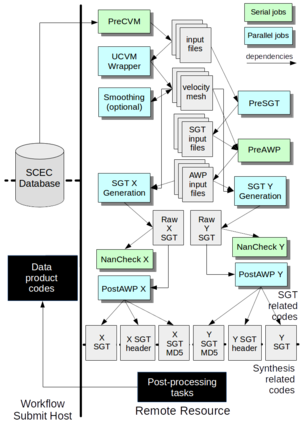CyberShake Code Base
This page details all the pieces of code which make up the CyberShake code base, as of November 2017. Note that this does not include the workflow middleware, or the workflow generators; that code is detailed at CyberShake Workflow Framework.
Conceptually, we can divide up the CyberShake codes into three categories:
- Strain Green Tensor-related codes: These codes produce the input files needed to generate SGTs, actually calculate the SGTs, and do some reformatting and sanity checks on the results.
- Synthesis-related codes: These codes take the SGTs and perform seismogram synthesis and intensity measure calculations.
- Data product codes: These codes insert the results into the database, and use the database to generate a variety of output data products.
Below is a description of each piece of software we use, organized by these categories. For each piece of software, we include a description of where it is located, how to compile and use it, and what its inputs and outputs are. At the end, we provide a description of input and output files and formats.
Contents
Code Installation
Historically, we have selected a root directory for CyberShake, then created the subdirectories 'software' for all the code, 'ruptures' for the rupture files, and 'utils' for workflow tools. Each code listed below, along with the configuration file, should be checked out into the 'software' subdirectory.
Configuration file
Many CyberShake codes use a configuration file, which specifies the root directory for the CyberShake installation, the command use to start an MPI executable, paths to a tmp and scratch space (which can be the same), and the path to the CyberShake rupture directory. We have done this instead of environment variables because it's more transparent and easier for multiple users. Both of these files should be stored in the 'software' subdirectory.
The configuration file is available at:
http://source.usc.edu/svn/cybershake/import/trunk/cybershake.cfg
Obviously, this file must be edited to be correct for the install.
Additionally, you must check out a Python script which is used to read in the configuration file and deliver it as key-value pairs, located here:
http://source.usc.edu/svn/cybershake/import/trunk/config.py
Several CyberShake codes import config, then use it to read out the cybershake.cfg file.

PreCVM
This code stands for "Pre-Community-Velocity-Model". It has to be run before the UCVM codes, since it generates input files required by UCVM.
Purpose: To determine the simulation volume for a particular CyberShake site.
Detailed description: PreCVM queries the CyberShake database to determine all of the ruptures which fall within a given cutoff for a certain site. From that information, padding is added around the edges to construct the CyberShake simulation volume for this site. Additional padding so the X and Y dimensions are multiples of 10, 20, or 40 might also be applied, depending on the input parameters. Using this volume, both the X/Y offset of each grid point, and then the latitude and longitude using a great circle projection, are determined and written to output files.
Needs to be changed if:
- The CyberShake volume depth needs to be changed, so as to have the right number of grid points. That is set in the genGrid() function in GenGrid_py/gen_grid.py.
- X and Y padding needs to be altered. That is set using 'bound_pad' in Modelbox/get_modelbox.py, around line 70.
- The rotation of the simulation volume needs to be changed. That is set using 'model_rot' in Modelbox/get_modelbox.py, around line 70.
- The database access parameters have changed. That's in Modelbox/get_modelbox.py, around line 80.
- The divisibility needs for GPU simulations change (currently, we need the dimensions to be evenly divisible by the number of GPUs used in that dimension. That is in Modelbox/get_modelbox.py, around line 250.
Source code location: http://source.usc.edu/svn/cybershake/import/trunk/PreCVM/
Author: Rob Graves, wrapped by Scott Callaghan
Dependencies:Getpar
Executable chain:
pre_cvm.py
Modelbox/get_modelbox.py
Modelbox/bin/gcproj
GenGrid_py/gen_grid.py
GenGrid_py/bin/gen_model_cords
Compile instructions:Run 'make' in the Modelbox/src and the Getpar_py/src directories.
Usage:
Usage: pre_cvm.py [options]
Options:
-h, --help show this help message and exit
--site=SITE Site name
--erf_id=ERF_ID ERF ID
--modelbox=MODELBOX Path to modelbox file (output)
--gridfile=GRIDFILE Path to gridfile (output)
--gridout=GRIDOUT Path to gridout (output)
--coordfile=COORDSFILE
Path to coorfile (output)
--paramsfile=PARAMSFILE
Path to paramsfile (output)
--boundsfile=BOUNDSFILE
Path to boundsfile (output)
--frequency=FREQUENCY
Frequency
--gpu Use GPU box settings.
--spacing=SPACING Override default spacing with this value.
--server=SERVER Address of server to query in creating modelbox,
default is focal.usc.edu.
Typical run configuration: Serial; requires 6 minutes for 100m spacing, 10 billion point volume
Input files: None; inputs are retrieved from the database
Output files: modelbox, gridfile, gridout, params, coord, bounds
UCVM
Purpose: To generate a populated velocity mesh for a CyberShake simulation volume.
Detailed description: UCVM takes the volume defined by PreCVM and queries the UCVM software to populate the volume. The resulting mesh is then checked for Vp/Vs ratio, minimum Vp/Vs/rho, and for no negative values or NaNs. The data is outputted in either Graves (RWG) format or AWP format.
Source code location: http://source.usc.edu/svn/cybershake/import/trunk/PreCVM/
Author: Rob Graves, wrapped by Scott Callaghan
Dependencies:Getpar
Executable chain:
pre_cvm.py
Modelbox/get_modelbox.py
Modelbox/bin/gcproj
GenGrid_py/gen_grid.py
GenGrid_py/bin/gen_model_cords
Compile instructions:Run 'make' in the Modelbox/src and the Getpar_py/src directories.
Usage:
Usage: pre_cvm.py [options]
Options:
-h, --help show this help message and exit
--site=SITE Site name
--erf_id=ERF_ID ERF ID
--modelbox=MODELBOX Path to modelbox file (output)
--gridfile=GRIDFILE Path to gridfile (output)
--gridout=GRIDOUT Path to gridout (output)
--coordfile=COORDSFILE
Path to coorfile (output)
--paramsfile=PARAMSFILE
Path to paramsfile (output)
--boundsfile=BOUNDSFILE
Path to boundsfile (output)
--frequency=FREQUENCY
Frequency
--gpu Use GPU box settings.
--spacing=SPACING Override default spacing with this value.
--server=SERVER Address of server to query in creating modelbox,
default is focal.usc.edu.
Typical run configuration: Serial; requires 6 minutes for 100m spacing, 10 billion point volume
Input files: None; inputs are retrieved from the database
Output files: modelbox, gridfile, gridout, params, coord, bounds